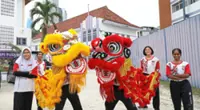IF THERE is one thing former two-time national and world champion Yess Cheong would like to point out about lion dancing is that it must be accompanied by live music.
“You need live drum beats to lead the lion,” he said.
Already a subscriber? Log in
Save 30% OFF The Star Digital Access
Cancel anytime. Ad-free. Unlimited access with perks.
Follow us on our official WhatsApp channel for breaking news alerts and key updates!
Thank you for your report!





